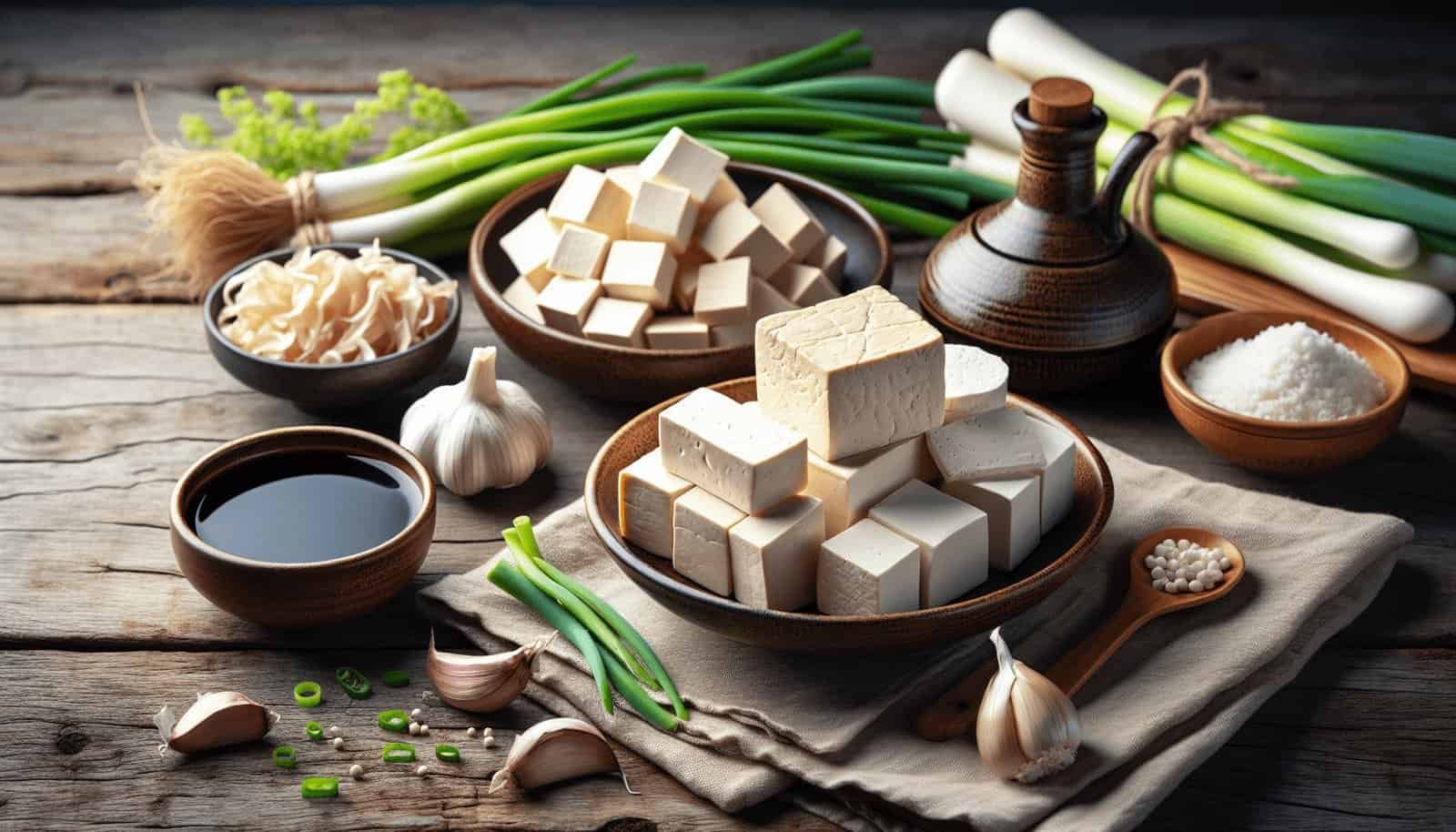When diving into the world of Korean cuisine, selecting the right type of tofu can elevate your dishes to new heights of flavor and texture. From soft and silky to firm and extra firm, each kind of tofu plays a unique role in various recipes, ensuring you get the best culinary experience. This guide will help you navigate the different types of tofu, so you can confidently choose the perfect one for your next Korean dish, whether it’s a hearty stew, a refreshing salad, or a savory stir-fry. Discover the versatility of tofu and make your Korean cooking adventures even more delightful! Have you ever found yourself standing in front of the tofu section at your local grocery store, feeling a bit overwhelmed by the variety of choices? You’re not alone! Choosing the right type of tofu for different Korean dishes may seem daunting, but once you get the hang of it, you’ll discover that each type has its own unique role in bringing out the best flavors in your cooking.

Understanding Tofu: The Basics
First things first, let’s break down what tofu really is. Tofu, also known as bean curd, is a versatile, protein-rich food made by coagulating soy milk and then pressing the curds into solid blocks. The texture of tofu can range from silky smooth to firm and extra-firm, depending on how much water is pressed out.
Types of Tofu
Tofu generally comes in several varieties, which can be broadly categorized into:
- Silken Tofu: Known for its delicate texture.
- Soft Tofu: Softer but with slightly more structure than silken tofu.
- Medium-Firm Tofu: Holds its shape better than soft tofu but still has a bit of softness to it.
- Firm Tofu: Easy to handle and versatile.
- Extra-Firm Tofu: Very sturdy and holds up well in hearty dishes.
These types can be used interchangeably to some extent, but knowing which one to use for specific dishes can elevate your Korean cooking game immensely.
Korean Dishes and Their Ideal Tofu Pairings
Savoring authentic Korean food often means getting the tofu just right. Let’s dive into some classic Korean dishes and explore which type of tofu is best suited for each.
Soondubu Jjigae (Silken Tofu Stew)
Soondubu Jjigae, a spicy stew made with silken tofu, vegetables, and often seafood or meat, is a staple in Korean cuisine. The creamy, custard-like texture of silken tofu balances the heat from the gochujang (Korean red chili paste) and the richness of the broth.
- Why Silken Tofu: Silken tofu blends seamlessly into the soup, providing a smooth and velvety texture that contrasts beautifully with the other ingredients.
Sundubu Jjigae (Soft Tofu Stew)
Not to be confused with Soondubu, Sundubu Jjigae often uses soft tofu, which has a bit more substance than silken tofu but still retains a delicate texture. This dish typically includes kimchi, pork, or seafood.
- Why Soft Tofu: Soft tofu ensures that the tofu pieces remain intact while still melting slightly into the soup, delivering a delightful mouthfeel.
Doenjang Jjigae (Fermented Soybean Paste Stew)
Doenjang Jjigae is another beloved Korean stew made with doenjang (fermented soybean paste), vegetables, and sometimes tofu. The tofu used here can vary, but a common choice is medium-firm to firm tofu due to the robust nature of the broth.
- Why Medium-Firm or Firm Tofu: These types of tofu maintain their shape and absorb the rich flavors of the doenjang, adding both texture and depth to the stew.
Dubu Kimchi (Stir-Fried Kimchi with Tofu)
Dubu Kimchi is a delightful dish that pairs spicy stir-fried kimchi with slices of pan-fried tofu. Firm or extra-firm tofu is the best choice for this dish.
- Why Firm or Extra-Firm Tofu: When pan-fried, these tofu types develop a crispy exterior while retaining a chewy center, perfectly complementing the tanginess of the kimchi.
Yubuchobap (Tofu Pouch Rice Balls)
Yubuchobap features sweet and savory rice wrapped in tofu pouches, often served as a side dish or appetizer. The tofu used in Yubuchobap is quite unique—it’s usually fried tofu pouches known as yubu.
- Why Fried Tofu Pouches (Yubu): These pouches are sturdy enough to hold the rice filling and have a pleasantly chewy texture that works well with the seasoned rice.
Tofu Salad (Dubu Salad)
For a refreshing and light meal, tofu salad is an excellent choice. Firm tofu is typically used here, sometimes lightly pan-fried to add a bit of crispness.
- Why Firm Tofu: It can hold its shape well, providing a satisfying bite, and contrasts nicely with the crisp vegetables and zesty dressing.
Tips for Cooking with Tofu
Handling tofu can be tricky if you’re new to it, so here are some helpful tips to ensure your tofu dishes come out perfect every time.
Pressing Tofu
If you’re using firm or extra-firm tofu, pressing it beforehand helps remove excess moisture, making it easier to achieve a crispier texture during cooking. To press tofu:
- Wrap the tofu block in a clean towel.
- Place it on a plate.
- Set a weight on top (a heavy skillet works well).
- Let it sit for at least 15-30 minutes.
Marinating Tofu
Tofu is like a sponge—it soaks up flavors beautifully. Marinating tofu before cooking can add an extra dimension of taste to your dishes. Simply marinate tofu cubes in a mixture of soy sauce, garlic, ginger, and a touch of sesame oil for about 30 minutes before cooking.
Stir-Frying Tofu
For stir-frying, firm or extra-firm tofu is your best bet. Cut the tofu into bite-sized pieces and either pan-fry them until golden brown or coat them lightly in cornstarch for added crispiness before stir-frying with your desired vegetables and sauces.
Table of Suggested Tofu Types for Korean Dishes
To make it easier to reference, here’s a handy table summarizing the ideal tofu types for various Korean dishes:
| Korean Dish | Recommended Tofu Type |
|---|---|
| Soondubu Jjigae | Silken Tofu |
| Sundubu Jjigae | Soft Tofu |
| Doenjang Jjigae | Medium-Firm or Firm Tofu |
| Dubu Kimchi | Firm or Extra-Firm Tofu |
| Yubuchobap (Yubu) | Fried Tofu Pouches (Yubu) |
| Tofu Salad (Dubu Salad) | Firm Tofu |

Nutritional Benefits of Tofu
Aside from its versatility in cooking, tofu boasts numerous health benefits:
High Protein Content
Tofu is an excellent source of plant-based protein, making it a great alternative for those trying to reduce their meat intake or follow a vegetarian or vegan diet.
Rich in Nutrients
Tofu is packed with essential nutrients such as calcium, iron, and magnesium. Silken tofu tends to have more calcium, while the firmer varieties are higher in protein and iron.
Heart Health
Studies suggest that soy-based products like tofu can help reduce bad cholesterol levels, potentially lowering the risk of heart disease.
Bone Health
The calcium and magnesium in tofu are good for maintaining strong bones, which is particularly useful for people with osteoporosis or those at risk of bone loss.
Exploring Different Regional Variations
Korean cuisine is rich and varied, with each region offering its own unique take on tofu dishes. Here are a few regional specialties to try:
Jeonju
Jeonju, known as the food capital of Korea, often features ingredients in their most authentic forms. Jeonju’s tofu-based dishes usually incorporate local vegetables and homemade broths.
- Dish to Try: Kongnamul Gukbap (Soybean Sprout Soup with Rice). This hearty soup often features traditional firm tofu for added texture.
Seoul
As the bustling urban center, Seoul embraces both traditional and contemporary dishes. In Seoul, you can find everything from classic Korean stews to innovative fusion dishes incorporating tofu.
- Dish to Try: Tofu Bulgogi (Marinated Tofu). Here, firm tofu can be marinated in a savory-sweet bulgogi sauce and grilled or pan-fried.
Jeju Island
Jeju Island, famous for its seafood, often combines tofu with fresh marine ingredients, creating a unique blend of flavors.
- Dish to Try: Haemul Sundubu (Seafood Soft Tofu Stew). This regional delicacy often uses soft tofu to complement the seafood’s delicate flavors.

Cooking Tips & Tricks from Korean Chefs
Hearing from the experts always adds valuable insights. Here are some tofu cooking tips from renowned Korean chefs:
Chef Baek Jong-won
- Tip: For Doenjang Jjigae, Chef Baek prefers using medium-firm tofu soaked in a light brine before cooking to enhance the tofu’s flavor absorption.
Chef Emily Kim (Maangchi)
- Tip: When making Dubu Kimchi, Maangchi recommends lightly dredging the tofu in flour before pan-frying it. This gives the tofu a crispier texture that pairs well with sautéed kimchi.
Chef Judy Joo
- Tip: Chef Judy suggests marinating tofu overnight in a soy-garlic mixture for dishes like Tofu Bulgogi. This allows the tofu to soak up maximum flavor.
Frequently Asked Questions (FAQs)
Curiosity often leads to common questions. Here are some frequently asked questions about choosing and using tofu in Korean dishes:
Can I Use Silken Tofu in Stir-Fry?
While silken tofu is best suited for soups and desserts, it doesn’t hold up well in stir-fries due to its delicate texture. Firm or extra-firm tofu is a much better choice for stir-frying.
How Do I Keep Tofu from Falling Apart?
Pressing your tofu before cooking helps firm it up and reduces its water content, making it sturdier. Additionally, handling it gently while cooking ensures it remains intact.
Is Frozen Tofu Different?
Yes, freezing tofu changes its texture, making it chewier and more sponge-like. This can be beneficial for absorbing marinades and sauces, but it’s not ideal for recipes requiring a smooth texture, like soups or stews.

Final Thoughts
Choosing the right type of tofu can really make a difference in your Korean cooking. By understanding the textures and flavor nuances of each variety, you can create more authentic and delicious dishes. From the silken tofu in Soondubu Jjigae to the firm tofu in Dubu Kimchi, each type plays a vital role in bringing Korean recipes to life.
So the next time you’re in the tofu aisle, you’ll know exactly which type to grab. Enjoy experimenting with different tofu types and Korean dishes to find your own perfect combinations. Happy cooking!
